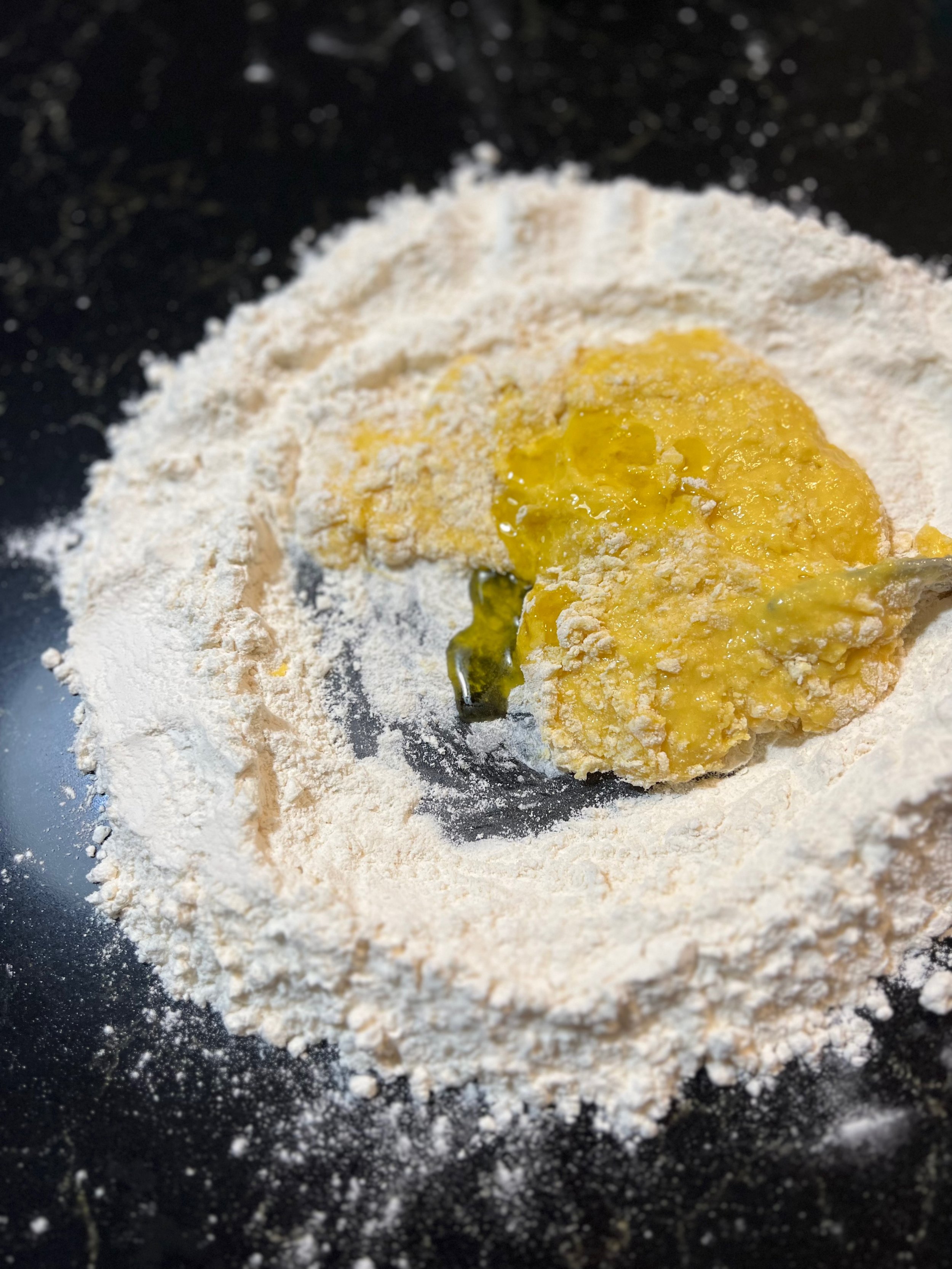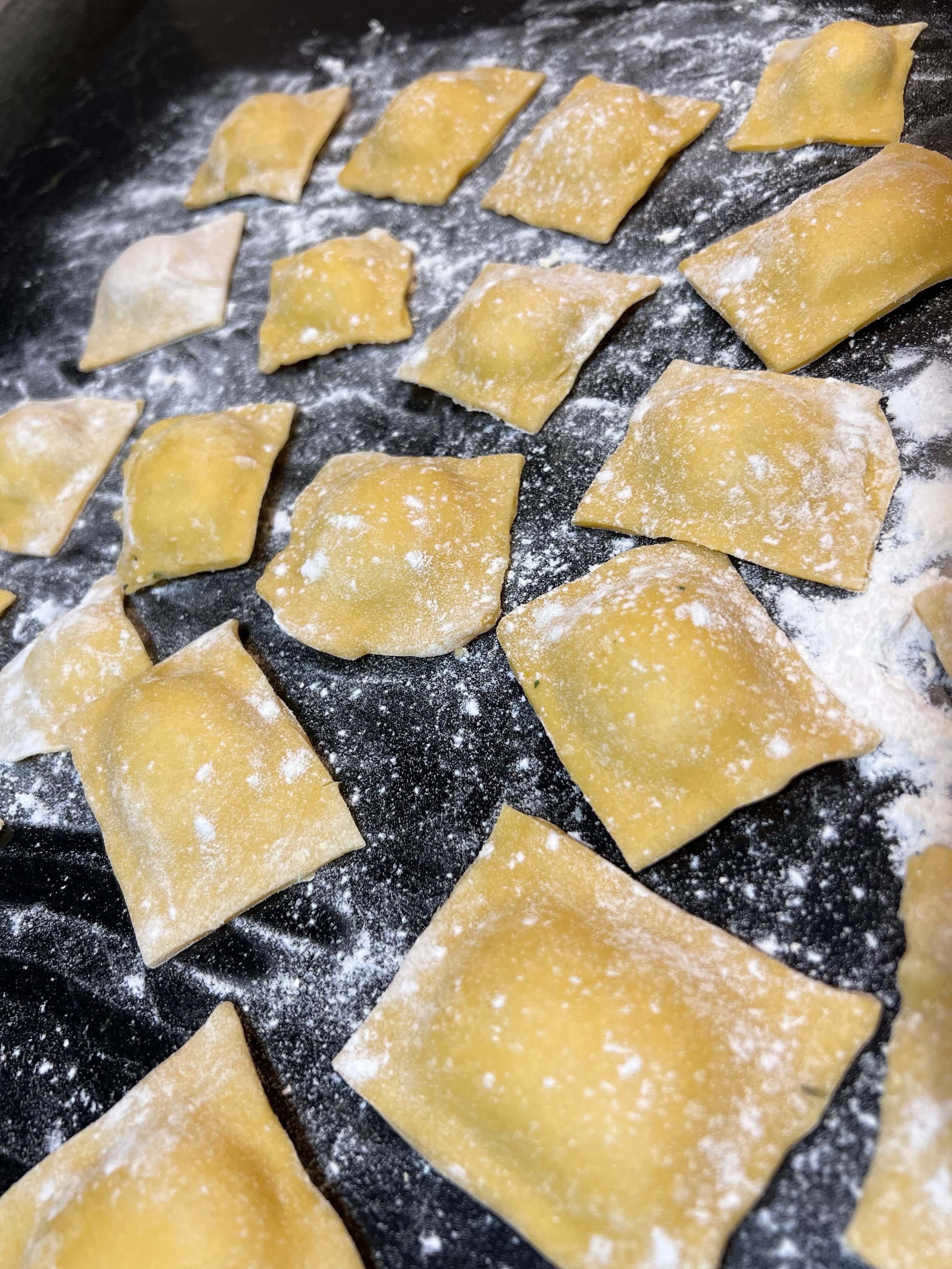Italy: Crab and Ricotta Ravioli in Sage Butter
So making ravioli is fairly straight forward even without the pasta making machine, but it certainly is easier if you have one! (I’ll assume you do not, for the sake of this recipe).
This one is a dish that packs plenty of seafood flavor, freshness from the lemon and coziness that come from the sage butter. Honestly, sage butter really does not get the spotlight it deserves in the culinary sphere.
Generally speaking when it comes to making ravioli, if you want to optimize your time, I recommend to start with making the dough. You’ll need to let the dough rest for roughly 30 minutes, and that’s a great time to make your filling.
What you’ll need
* This is your entire shopping list, I’ll explain what goes for the dough and what for the filling in a bit
6 medium eggs
300g flour (roughly, depends on flour and size of eggs, really)
150-200g white crab meat
Zest of 1 lemon
100g parmigiano (and then more for grating on top)
2 cloves of garlic
200-250g ricotta
Parsley
Chilli powder
Salt & Pepper
Olive oil
Oregano (I used dried here)
Sage
Butter (I used around 100g)
Tools you’ll need:
Rolling pin, brush (And a cookie cutter or the squiggly rolling cutter thing if you’re fancy like that, I guess.. I’m not)
Now… First thing first.. the dough!
Separating the yolks
There are a number of ways to do this, but honestly the easiest is to break the full egg into a tin where you will keep your whites and then just scooping out the yolk with your hand. Be careful, but it works better than you’d think!
I say where you’ll keep your egg whites, because although you won’t need them anymore here, there are many great recipes you can use them for!
Start by putting your flour on to a clean surface. Make a small little well in the middle of it - this is where your eggs and yolks will be going.
Here, you’ll be using 5 of your eggs. The first egg goes fully into the dough mix, but the rest will just be yolks. For this, spoiler alert, you will need to separate the yolks from the egg whites.
Depending on the size of your eggs, you may need a bit more or less flour than I outlined.
You want the dough to have a nice consistency but not be too dry. So here you’ll need to really watch for how the ingredients come together.
Break up your egg yolks and white and gently mix them in the middle of the flour.
Once the mixture is more or less consistent, you can start to incorporate the perimeter flour, little by little. Do mind not to break the borders down and have it spill everywhere. Here, you’re working inside out.
Once the mixture looks like it is coming together and is getting a bit more solid, you can add a few drops of olive oil in to the mix (like in the image below).
At this point you can also let go of the folk and start to slowly knead the dough with your hands, gathering the flour as you go until you have a good consistency.
Let it rest
Once you feel the gluten activate from your kneading (it’ll be come elastic, malleable), shape the dough in to a ball and rub a bit of olive oil on it.
Then, cover your dough in cling film and let it rest for about 30 minutes.
Make your filling
While your dough rests, you can make your filling.
In a large bowl, mix together your crab, ricotta, parmigiano, parsley, garlic and lemon zest.
Season to taste with salt, black pepper and chili powder and oregano.
I opted for the dried oregano mostly because it was a last minute decision to include it. Fresh is always better, but I do think this recipe benefits from some oregano.
Remember your last egg?
Well, nows the time!
Use this time to also beat this one egg into an egg wash and keep on the side.
This is for the ravioli assembly - the egg wash sticks the dough together, allowing your to close the parcels.
Now the assembly!
Take a part of your dough and roll it out in to what can resemble best a flat rectangle
(yes, this was my best shot)
You will need to position your filling on the lower half of the dough piece.
Use your egg wash to brush generously the perimiter of the filling.
Fold over the other half (here it is the left side of the dough) over your filling portions.
start to work around the filling, making sure you’re minimizing the amount of air trapped in the pocket with the filling and that you’re closing it firmly.
Cut and repeat
Once you’re closed the ravioli, you just cut them in the middle of the closure areas. I used a regular knife for this, but if you want to kick it up a notch, or just really like swirly edges, you can use a cookie cutter or one of those rolling, squiggly mini pizza cutter things.
Ok, I just looked it up and it is called a pastry wheel.. The more you know!
Either way, this has the whole set of options for you. Here is a reference to your heart’s content.
As you’re working, make sure to keep the surface dusted with flour, or you’ll have some difficult moments peeling these off the table.
Once cut, dust them in flour and keep on side.
Keep going until you’ve gone through all of your dough.
You can also knead the scraps you will have together to probably get a few more parcels in.
Time to cook!
Once you’re done with all of the dough, you’re ready to make the ravioli!
Bring a pot of water to a boil, with a ton of salt in it. Cook your ravioli until just about el dente.
As you drop them in, gently stir the pot, in case they decide to start sticking together or to the bottom.
As your ravioli is almost done, get your butter and sage into a frying pan.
Transfer to pan
With a slotted spoon, transfer your ravioli to the frying pan. Make sure the pan is very hot.
Fry until golden
Fry up your ravioli until they start to crisp up a bit and the butter and sage begin to brown. Toss to coat and make sure to turn your ravioli to get them on different sides.
Serve your ravioli to a plate. Pour over with a bit of the sage butter from the pan and a dash of olive oil.
Season with freshly ground black pepper and freshly grated parmigiano cheese.
Wine pairing!
If we’re keeping with the Italian theme, I think this dish pairs well with a Grechetto.
Alternatively, I’d recommend a Chablis.
















